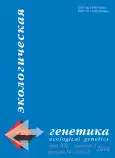On the photoperiodic induction of diapause in first generation hybrids of Harmonia Axyridis (PALL.) (Coleoptera, Coccinellidae)
- Authors: Reznik S.Y.1, Ovchinnikov A.N1, Ovchinnikova A.A1, Belyakova N.A2, Barabanova L.V3
-
Affiliations:
- Zoological Institute RAS
- All-Russian Institute of Plant Protection
- St Petersburg State University
- Issue: Vol 14, No 2 (2016)
- Pages: 39-42
- Section: Articles
- URL: https://journals.rcsi.science/ecolgenet/article/view/3600
- DOI: https://doi.org/10.17816/ecogen14239-42
- ID: 3600
Cite item
Full Text
Abstract
Full Text
##article.viewOnOriginalSite##About the authors
Sergey Ya Reznik
Zoological Institute RAS
Email: reznik1952@mail.ru
Head of Laboratory of Experimental Entomology
Andrey N Ovchinnikov
Zoological Institute RAS
Email: Andrey.Ovchinnikov@zin.ru
Researcher, Laboratory of Experimental Entomology
Antonina A Ovchinnikova
Zoological Institute RAS
Email: enoty@mail.ru
Junior Researcher, Laboratory of Experimental Entomology
Natalia A Belyakova
All-Russian Institute of Plant Protection
Email: belyakovana@yandex.ru
Head of Laboratory of Biological Control
Larisa V Barabanova
St Petersburg State University
Email: lbarabanova@mail.ru
Associate Professor, Department of Genetics & Biotechnology
References
- Виноградова Е.Б. Диапауза мух и ее регуляция. - СПб.: Наука, 1991. [Vinogradova EB. Diapause in flies and its control. Saint Petersburg: Nauka; 1991. (In Russ).]
- Виноградова Е.Б., Карпова С.Г. Сезонные и суточные ритмы кровососущих комаров. - СПб.: ЗИН РАН, 2010. [Vinogradova EB, Karpova SG. Seasonal and circadian rhythms in bloodsucking mosquitoes. Saint Petersburg: ZIN RAN; 2010. (In Russ).]
- Данилевский А.С. Фотопериодизм и сезонное развитие насекомых. - Л.: Изд-во ЛГУ, 1961. [Danilevskiy AS. Photoperiodism and seasonal development of insects. Leningrad: Izd-vo LGU; 1961. (In Russ).]
- Саулич А.Х., Волкович Т.А. Экология фотопериодизма насекомых. - СПб.: Изд-во СПбГУ, 2004. [Saulich AKh, Volkovich TA. Ecology of insect photoperiodism. Saint Petersburg: Izd-vo SPbGU; 2004. (In Russ).]
- Справочник по прикладной статистике. Т. 1 / Под ред. Э. Ллойда, У. Ледермана, Ю. Н. Тюрина. - М.: Финансы и статистика, 1989. [Handbook of applied statistics. Vol. 1 E Lloyd, U Lederman, YuN. Tyurin, editors. Moscow: Finansy i statistika; 1989. (In Russ).]
- Chen C, Xia QW, Chen YS, et al. Inheritance of photoperiodic control of pupal diapause in the cotton bollworm, Helicoverpa armigera (Hubner). J Insect Physiol. 2012;58(12):1582-1588. doi: 10.1016/j.jinsphys.2012.09.013.
- Facon B, Pointie JP, Jarne P, et al. High genetic variance in life-history strategies within invasive populations by way of multiple introductions. Curr Biol. 2008;18(5):363-367. doi: 10.1016/j.cub.2008.01.063.
- Facon B, Crespin L, Loiseau A, et al. Can things get worse when an invasive species hybridizes? The harlequin ladybird Harmonia axyridis in France as a case study. Evol Appl. 2011;4(1):71-88. doi: 10.1111/j.1752-4571.2010.00134.x.
- Handley LJL, Estoup A, Evans DM, et al. Ecological genetics of invasive alien species. BioControl. 2011;56(4):409-428. doi: 10.1007/s10526-011-9386-2.
- Hodek I. Diapause / dormancy. In: Hodek I, van Emden HF, Honek A, editors. Ecology and behaviour of the ladybird beetles. Chichester: Wiley-Blackwell; 2012;275-342.
- Reznik SY, Dolgovskaya MY, Ovchinnikov AN, Belyakova NA. Weak photoperiodic response facilitates the biological invasion of the harlequin ladybird Harmonia axyridis (Pallas) (Coleoptera: Coccinellidae). J Appl Entomol. 2015;139(4):241-249. doi: 10.1111/jen.12158.
- Roy HE, Brown PM, Adriaens T, et al. The harlequin ladybird, Harmonia axyridis: global perspectives on invasion history and ecology. Biol Invas. 2016;18(4):997-1044. doi: 10.1007/s10530-016-1077-6.
- Saunders DS, Steel CGH, Vafopoulou X, Lewis RD. Insect clocks. Amsterdam: Elsevier; 2002.
- Sloggett JJ. Harmonia axyridis invasions: deducing evolutionary causes and consequences. Entomol Sci. 2012;15(3):261-273. doi: 10.1111/j.1479-8298.2012.00519.x.
- Sloggett JJ, Honek A. Genetic studies. In: Hodek I, van Emden HF, Honek A, editors. Ecology and behaviour of the ladybird beetles. Chichester: Wiley-Blackwell; 2012;13-53.
- Tauber MJ, Tauber CA, Masaki S. Seasonal adaptations of insects. New York: Oxford University Press; 1986.
- Turgeon J, Tayeh A, Facon B, et al. Experimental evidence for the phenotypic impact of admixture between wild and biocontrol Asian ladybird (Harmonia axyridis) involved in the European invasion. J Evol Biol. 2011;24(5):1044-1052. doi: 10.1111/j.1420-9101.2011.02234.x.
- Ukrainsky AS, Orlova-Bienkowskaja MJ. Expansion of Harmonia axyridis Pallas (Coleoptera: Coccinellidae) to European Russia and adjacent regions. Biol Invas. 2014;16(5):1003-1008. doi: 10.1007/s10530-013-0571-3.
- Xiao L, He HM, Zhong PS, et al. Inheritance of photoperiodic control of larval diapause in the Asian corn borer Ostrinia furnacalis (Guenée). Bull Entomol Res. 2015;105(3):326-334. doi: 10.1017/S0007485315000140.
Supplementary files






